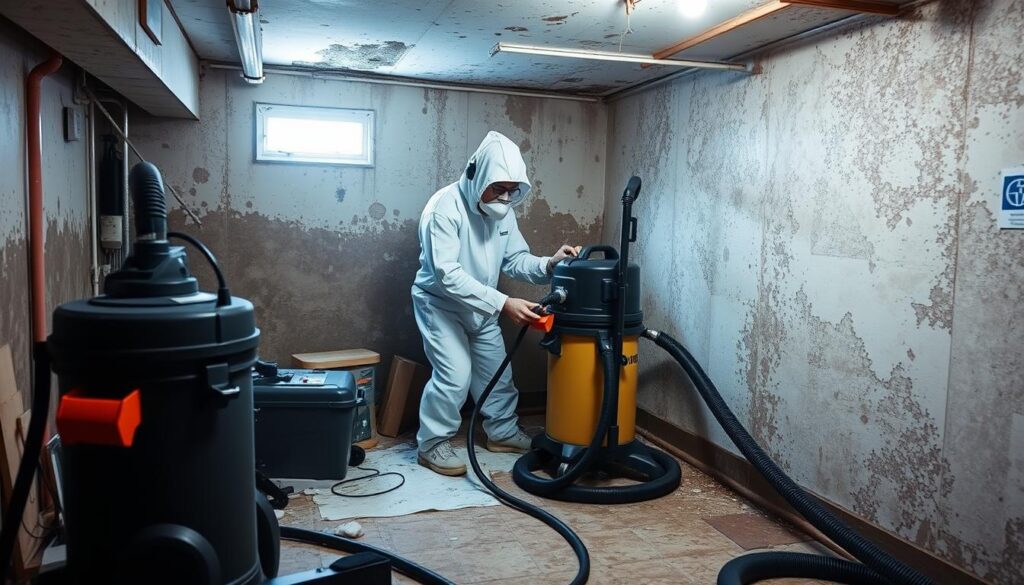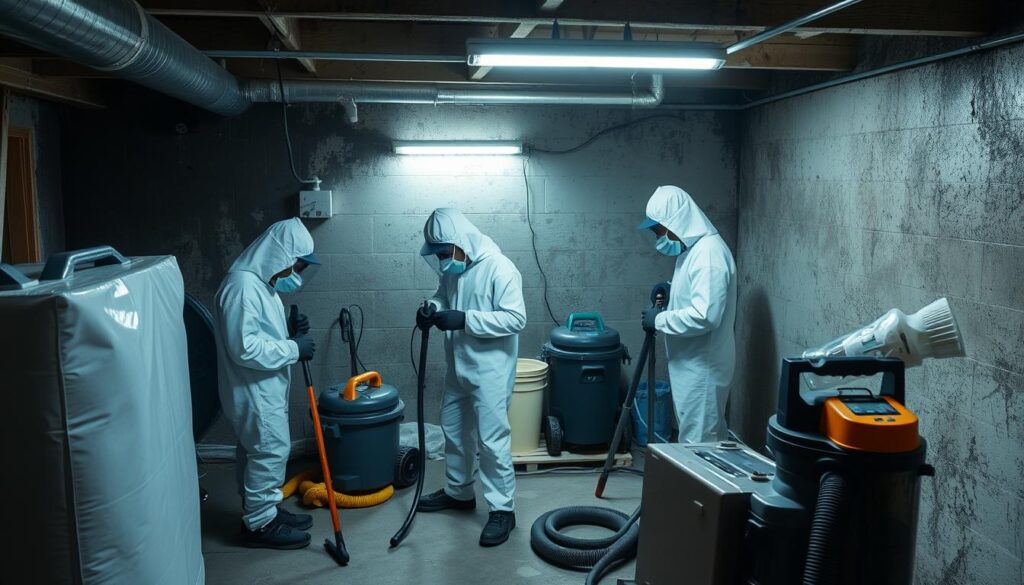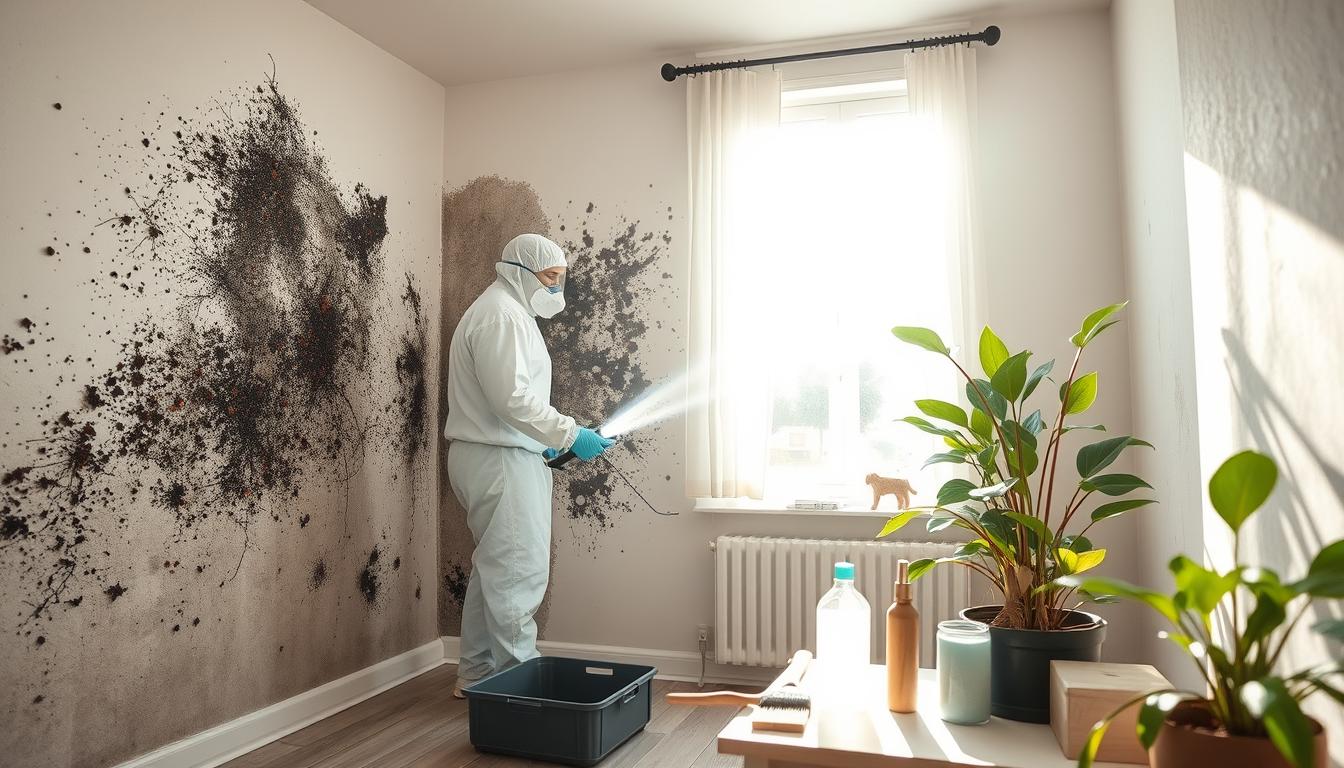Did you know black mold affects 70% of homes in the U.S.? This shows how urgent it is to find good ways to get rid of it. I’ll talk about removing mold, stopping toxic mold, and making air inside homes better.
Black mold hides in damp spots in our homes and can harm our health. It can cause allergies and breathing problems. That’s why I want to find safe and effective ways to deal with black mold remediation.
In this guide, I’ll cover the basics of finding black mold, knowing its health risks, and fighting it. Whether you have a small spot or a big problem, I’ll offer helpful tips and expert advice.
Let’s start this journey to make our homes healthier and free from mold. By the end of this article, you’ll know how to keep your home and family safe from black mold.
Key Takeaways
- Black mold affects 70% of U.S. homes, emphasizing the need for effective remediation
- Proper identification and understanding of health risks are crucial
- Professional remediation is recommended for larger infestations
- DIY solutions are suitable for areas smaller than 10 square feet
- Prevention involves controlling moisture and improving ventilation
- Regular inspections and prompt action are key to maintaining a mold-free home
Understanding Black Mold: What You Need to Know
Black mold is a serious issue for homeowners. With over 100,000 mold types worldwide, black mold is especially dangerous. It’s crucial to regularly check for mold and test the air quality indoors.
Identifying Black Mold in Your Home
Black mold, also known as Stachybotrys chartarum, grows in warm, damp places. It eats organic stuff in buildings. When I inspect for mold, I look for dark patches and a musty smell, especially where it’s wet.
Health Risks Associated with Black Mold Exposure
Being around black mold can cause health problems. You might cough, sneeze, get eye irritation, skin rashes, headaches, or nosebleeds. Long-term exposure can also lead to asthma and breathing issues. That’s why I always test for mold in my home.
Common Areas Where Black Mold Thrives
Black mold loves homes in Southern states and places hit by severe storms. It’s important to check these spots:
- Bathrooms
- Basements
- Kitchens
- Attics with bad air flow
- Places with water damage
To keep mold away, I keep humidity levels between 30-50%. I also use exhaust fans in bathrooms and kitchens. This helps keep the air clean and stops mold from growing.
| Mold Type | Toxicity | Cleaning Method |
|---|---|---|
| Toxic Black Mold | High | Professional remediation |
| Non-Toxic Black Mold | Low | Store-bought cleaners |
The Importance of Professional Black Mold Remediation
Professional mold remediation services are crucial for black mold. Experts have the knowledge and tools to handle tough mold problems. With over 185 species of Aspergillus mold, it’s important to have professionals who know how to deal with different types.

- Thorough mold assessment to identify the extent and source of the problem
- Effective removal using specialized equipment like HEPA vacuums
- Prevention of future mold issues by addressing underlying moisture problems
- Expert guidance on improving ventilation and maintaining proper humidity levels
- Cost savings by preventing extensive property damage and repeated treatments
Mold mitigation companies do more than just clean up. They assess environmental impacts, use EPA-approved treatments, and use advanced techniques. This ensures mold is removed and air quality improves.
For big mold problems or toxic black mold, you need professionals. They have the right safety gear and know-how to handle dangerous situations. This protects your property and health.
Choosing professional mold remediation is a wise decision. It protects your property value, improves air quality, and gives you peace of mind. With their help, you can be sure your mold issue will be solved right.
DIY Black Mold Removal: When and How to Tackle Small Infestations
Handling small black mold problems can be doable for homeowners. If the mold covers less than 10 square feet, you might be able to clean it up yourself. But always put safety first when dealing with mold.
Safety Precautions for DIY Mold Removal
Before you start cleaning mold, make sure you’re prepared. Wear gloves, goggles, and an N-95 face mask. This protects you from mold spores that can harm your health and air quality.
Step-by-Step Guide for Small-Scale Black Mold Cleanup
Here’s how I handle DIY mold removal:
- Find and fix the moisture problem
- Seal off the area with plastic sheeting
- Mist the moldy area with water
- Scrub gently with a detergent solution
- Use a HEPA vacuum to clean
- Wipe clean with a damp cloth
- Dry the area completely
Natural and Chemical Solutions for Mold Removal
I’ve found both natural and commercial cleaners work for mold. Vinegar and baking soda are good for small spots. For bigger jobs, I use commercial products. Always make sure the area is well-ventilated when cleaning.
If the mold is widespread or you’re not sure what to do, call a professional. They can remove the mold completely and improve your air quality.
Advanced Techniques for Effective Black Mold Remediation
I’ve learned that professional mold mitigation services are key for big black mold problems. Experts use special methods for areas over 10 square feet. This ensures mold is fully removed and air quality improves.

Experts use HEPA vacuums to catch 99.97% of tiny particles. These tools are great at removing mold spores from the air and surfaces. This greatly reduces contamination.
Air scrubbers are another important tool. They filter the air, trapping mold spores and pollutants. Used with negative air machines, they keep mold from spreading during cleanup.
- HEPA vacuuming for thorough spore removal
- Air scrubbers to enhance indoor air quality
- Negative air machines to contain mold spread
- Soda blasting for effective surface cleaning
Experts also use antimicrobial treatments to kill spores and stop future growth. This complete method ensures mold is effectively removed and results last. Remember, acting fast is crucial to avoid serious health issues.
Professional mold remediation services are crucial for thoroughly removing mold and resolving moisture problems.
By using these advanced methods, certified experts can remove black mold. They help keep your home healthy for you and your family.
Preventing Future Black Mold Growth in Your Home
I’ve learned that mold prevention is key to maintaining a healthy living space. By taking proactive steps, we can significantly reduce the risk of black mold growth and improve our indoor air quality.
Controlling Moisture and Humidity Levels
Keeping humidity below 50% is crucial for mold prevention. I use dehumidifiers and air conditioners to maintain optimal levels. It’s important to fix leaks promptly and ensure proper drainage around the home.
In fact, after a flood, thorough drying within 24-48 hours can prevent mold growth.
Improving Ventilation and Air Circulation
Good air circulation is essential for mold prevention. I use exhaust fans in kitchens and bathrooms to remove excess moisture. Opening windows when weather permits helps improve indoor air quality.
Adding mold inhibitors to paint can provide an extra layer of protection.
Regular Inspections and Maintenance
Regular mold inspections are vital. I check areas prone to moisture accumulation frequently. Cleaning with mold-killing products and maintaining HVAC systems help prevent mold growth.
For small mold problems, I use household cleaners or a bleach solution, following safety guidelines.
“Quick action and thorough cleaning are essential in preventing mold recurrence.”
Remember, visible mold doesn’t require testing. For larger problems (over 10 square feet), professional help might be necessary. By following these steps, we can create a healthier, mold-free home environment.
Black Mold in HVAC Systems: Detection and Remediation
Mold in HVAC systems is a big problem that can harm your indoor air. It’s important to fix it fast to stop mold spores from spreading. Mold loves moist places, making HVAC systems perfect for it.
There are three main spots where mold can grow in an HVAC system:
- Air ducts
- Evaporator coil
- Drain pan
Causes of mold growth include leaking ducts, big AC units, high humidity, and bad ventilation. If you get sick when your HVAC is on, it’s time for a mold inspection.
For small mold, you might handle it yourself. But for big areas, get a pro. Costs for fixing HVAC mold range from $500 to $2500, based on the problem size.
To stop mold in your HVAC system:
- Change filters often
- Run your system regularly
- Get annual checks
If you think there’s mold in your HVAC, turn it off right away to stop it from spreading. Professional tests can find and identify mold, helping fix it and improve air quality.
The Role of Professional Mold Testing in Remediation
Professional mold testing is key for effective remediation. As a homeowner, you might not see mold in hidden spots. That’s where expert mold inspection helps.
Mold testing services offer many benefits. They catch mold growth early, preventing health risks. They also tell us what type of mold we’re facing. This is important because different molds can be more or less toxic.
Here’s why professional mold testing is a big deal:
- Pinpoints hidden mold growth
- Identifies the specific type of mold present
- Guides targeted mold remediation services
- Protects your family’s health
Mold can start growing just 24 hours after a water incident. That’s why quick action is important. Professional testers use advanced tools for fast, accurate results.
“Professional mold testing empowers homeowners with knowledge to make informed decisions about their living environment.”
While DIY kits are available, they often don’t work well. Professional mold testing services give a detailed look at your indoor air quality. This is crucial for a good cleanup plan.
| Aspect | DIY Testing | Professional Testing |
|---|---|---|
| Accuracy | Often inaccurate | Highly accurate |
| Comprehensiveness | Limited | Thorough |
| Tools Used | Basic kit | Advanced equipment |
| Expertise | None | Trained professionals |
We spend about 90% of our time indoors. Investing in professional mold testing is a smart move for your family’s health and peace of mind.
Legal Considerations and Insurance Coverage for Mold Damage
Dealing with mold damage can be tricky, especially when it comes to legal matters and insurance. Many homeowners find out that standard insurance policies often don’t cover mold damage. The average cost of mold remediation in the United States is $2,235, which can be a big expense if you’re not covered.
Insurance companies usually only cover mold damage if it happens suddenly and accidentally, like a burst pipe. They won’t cover damage from neglect or lack of maintenance. It’s important to check your policy and think about getting extra coverage, especially if you live in a place where mold is more common. Some insurers offer mold remediation coverage as an optional add-on.
Legal issues with mold damage can be complex. Landlords and tenants have specific duties regarding mold prevention and cleanup. In real estate deals, there are rules about disclosing mold problems. It’s key to tackle mold issues quickly, as the Federal Emergency Management Agency says mold can grow on damp surfaces in just 24 hours.
To protect yourself, focus on preventing mold. Keep indoor humidity levels below 60%, clean up water leaks fast, and make sure there’s good ventilation. Regular upkeep and checks can help you avoid expensive mold damage and legal problems later on.
FAQ
What is black mold and how can I identify it in my home?
Black mold refers to several dark-colored fungi. They appear as brownish-black or greenish-black dots on surfaces. These fungi thrive in moist places.
Look for dark color and a musty smell to spot black mold. It often grows in bathrooms, basements, kitchens, and areas with water damage or poor ventilation.
What are the health risks associated with black mold exposure?
Black mold can cause allergic reactions and asthma attacks. It can also lead to respiratory issues. People with weakened immune systems are at higher risk.
It’s important to deal with black mold quickly to keep your home safe.
Why is professional black mold remediation important?
Professional mold removal ensures safe and effective cleaning. Experts have the right training and tools for the job. They can find out how bad the mold is and what types are present.
They also know how to clean without spreading mold. This helps keep your home safe and clean.
When is DIY black mold removal appropriate?
DIY mold removal works for small infestations under 10 square feet. It’s important to wear protective gear and fix the moisture source first.
Use the right cleaning solutions or natural remedies. This way, you can safely clean up the mold yourself.
What advanced techniques are used for effective black mold remediation?
Advanced techniques include using HEPA air scrubbers and negative air machines. These tools help control mold spores and improve air quality.
Experts also use moisture meters to dry areas properly. They might remove and replace damaged materials and apply treatments to prevent future growth.
How can I prevent future black mold growth in my home?
To stop mold, control moisture and improve ventilation. Keep humidity below 50% and fix leaks quickly.
Use exhaust fans in kitchens and bathrooms. Regularly check areas that get wet. Keeping your HVAC system clean and your gutters clear also helps.
How can I detect and remediate black mold in my HVAC system?
Check your HVAC system often for mold. Look for musty smells, visible mold, and allergy symptoms. If you find mold, clean the air ducts and replace damaged insulation.
Fix any moisture issues. Getting your HVAC system professionally cleaned is key to preventing mold and keeping the air clean.
Why is professional mold testing important in the remediation process?
Mold testing is key for effective cleaning. It shows how bad the mold is and what types you have. This guides the cleaning process.
Testing can include air, surface, and bulk samples. It helps check if the cleaning was successful and if mold levels are safe.
What legal considerations and insurance coverage should I be aware of for mold damage?
Mold damage raises legal questions about who is responsible. It also affects insurance coverage. Most policies don’t cover mold damage, especially if it’s caused by neglect.
Review your policy and consider extra coverage if you live in a mold-prone area.




